Progress in Research on Ni-Based Protective Coatings for Downhole Tubing Steel in CO2 Flooding
Abstract
:1. Introduction
2. Corrosion of CO2 Flooding Tubing Steels
2.1. Influence of CO2 Partial Pressure
2.2. Influence of H2S Concentration
2.3. Quantitative Analysis of PCO2/PH2S
3. Ni-P Coating
4. Research Status of Corrosion Resistance of Reinforced Ni-P Coating
4.1. Ni-Fe-P Coating
4.2. Ni-Cu-P Coating
4.3. Ni-W-P Coating
4.4. Ni-W-P-nSiO2 Coating
5. Summary and Expectation
Funding
Institutional Review Board Statement
Informed Consent Statement
Data Availability Statement
Conflicts of Interest
References
- Lv, G.; Li, Z.; Li, X.; Zhang, J.; Wang, S. Technology and Application of CO2 Capture, Utilization and Storage for Coal fired Power Plant. Sci. Technol. Rev. 2014, 32, 40–45. [Google Scholar]
- Hu, Y.; Hao, M.; Chen, G.; Sun, R.; Li, S. Technologies and practice of CO2 flooding and sequestration in China. Pet. Explor. Dev. 2019, 12, 716–727. [Google Scholar] [CrossRef]
- Marbun, B.T.H.; Santoso, D.; Kadir, W.G.A.; Wibowo, A.; Sule, R. Improvement of borehole and casing assessment of CO2-EOR/CCUS injection and production well candidates in Sukowati Field, Indonesia in a well-based scale. Energy Rep. 2021, 7, 1598–1615. [Google Scholar] [CrossRef]
- Yang, W.; Zhao, X.; Sun, C.; Xu, X.; Sun, J. Corrosion behavior of X65 steel in gaseous and liquid CO2 transport environments containing multiple impurities and different H2O content. IOP Conf. Ser. Mater. Sci. Eng. 2024, 2686, 12–18. [Google Scholar] [CrossRef]
- Wu, B.; Song, Z.; Chen, P. Corrosion Behavior of N80/J55 Tubing Steel in Supercritical CO2/H2O System. Drill. Prod. Technol. 2021, 44, 66–70. [Google Scholar]
- Sun, C.; Sun, J.; Liu, S.; Wang, Y. Effect of water content on the corrosion behavior of X65 pipeline steel in supercritical CO2-H2O-O2-H2S-SO2 environment as relevant to CCS application. Corros. Sci. 2018, 137, 151–162. [Google Scholar] [CrossRef]
- Sun, C.; Liu, J.; Sun, J. Probing the Initial Corrosion Behavior of X65 Steel in CCUSEOR Environments with Impure Supercritical CO2 Fluids. Corros. Sci. 2021, 189, 109585. [Google Scholar] [CrossRef]
- Xu, X.; Miao, J.; Bai, Z.; Feng, Y.; Ma, Q.; Zhao, W. The corrosion behavior of electroless Ni–P coating in Cl−/H2S environment. Appl. Surf. Sci. 2012, 258, 8802–8806. [Google Scholar]
- Ashassi-Sorkhabi, H.; Es’Haghi, M. Corrosion resistance enhancement of electroless Ni–P coating by incorporation of ultrasonically dispersed diamond nanoparticles. Corros. Sci. 2013, 77, 185–193. [Google Scholar] [CrossRef]
- Liu, H.; Guo, R.X.; Zong, Y.; Bian, J.S.; Li, S. Annealing crystallization and wear behavior of electroless deposited Ni-P and Ni-W-P coatings. Trans. Mater. Heat Treat. 2011, 32, 139–145. [Google Scholar]
- Luo, H.; Leitch, M.; Behnamian, Y.; Ma, Y.; Zeng, H.; Luo, J. Development of electroless Ni–P/nano-WC composite coatings and investigation on its properties. Surf. Coat. Technol. 2015, 277, 99–106. [Google Scholar] [CrossRef]
- Ghavidel, N.; Allahkaram, S.R.; Naderi, R.; Barzegar, M.; Bakhshandeh, H. Corrosion and wear behavior of an electroless Ni-P/nano-SiC coating on AZ31 Mg alloy obtained through environmentally-friendly conversion coating. Surf. Coat. Technol. 2019, 382, 125156. [Google Scholar] [CrossRef]
- Kousar, H.; Umer, M.A.; Shehzad, K.; Ferdous, R.; Mehmood, K.; Basit, A.; Shahbaz, T.; Yasir, M.; Shakoor, A. Exceptional mechanical properties and wear behavior of Al2O3 nanoparticle reinforced Ni-W-P coatings. Tribol. Int. 2024, 194, 109533. [Google Scholar] [CrossRef]
- Zhang, Y.; Kang, M.; Li, H.; Liu, Y. Study of the corrosion resistance of a superhydrophobic Ni-P-Al2O3 composite coating based on electrochemical machining. Int. J. Electrochem. Sci. 2019, 14, 6032–6044. [Google Scholar] [CrossRef]
- He, Z.; Zhou, Y.; Wang, Y.; Guo, P.; Jiang, W.; Yao, C.; Shu, X. Preparation and properties of Ni-W-P-TiO2 nanocomposite coatings developed by a sol-enhanced electroplating method. Chin. J. Chem. Eng. 2021, 44, 369–376. [Google Scholar] [CrossRef]
- Cui, G.; Bi, Z.; Liu, J.; Wang, S.; Li, Z. New method for CO2 corrosion resistance Ni-W-Y2O3-ZrO2 nanocomposite coatings. Ceram. Int. 2019, 45, 6163–6174. [Google Scholar] [CrossRef]
- Chinchu, K.S.; Riyas, A.H.; Sha, M.A.; Geethanjali, C.V.; Saji, V.S.; Shibli, S.M. ZrO2–CeO2 assimilated electroless Ni–P anti-corrosion coatings. Surf. Interface 2020, 21, 100704. [Google Scholar] [CrossRef]
- Cheng, W.; Wen, P.; Wang, T.; Yu, H.; Jiang, M.; Wen, H.; Wang, B. A study of Ni–P electroless coating modified by rare earth oxide (La2O3, Y2O3 and Ce2O3) on pre-phosphorized zirconium alloy. Ferroelectrics 2023, 606, 161–174. [Google Scholar] [CrossRef]
- Elgaddafi, R.; Ahmed, R.; Shah, S. Corrosion of carbon steel in CO2 saturated brine at elevated temperatures. J. Pet. Sci. Eng. 2020, 196, 107638. [Google Scholar] [CrossRef]
- Dong, B.; Zeng, D.; Favero, C.; Divers, T.; Boisse, N.; Xu, Q.; Ling, J.; Xie, K.; Wang, Q. Insight into polymer concentration, temperature, CO2 content, and Cl− content on corrosion of N80 steel tubing in polymer flooding. Mater. Corros. 2023, 74, 943–961. [Google Scholar] [CrossRef]
- Cui, Z.; Wu, S.; Zhu, S.; Yang, X. Study on corrosion properties of pipelines in simulated produced water saturated with supercritical CO2. Appl. Surf. Sci. 2006, 252, 2368–2374. [Google Scholar] [CrossRef]
- Li, D.; Han, D.; Zhang, L.; Lu, M.; Wang, L.; Ma, W. Effects of temperature on CO2 corrosion of tubing and casing steel. NACE-Int. Corros. Conf. Ser. 2013, 17, 2426. [Google Scholar]
- Lu, S.; Liu, W.; Zhang, S.; Qi, X.; Li, X.; Wang, X. Corrosion Performance of Carbon Steel in CO2 Aqueous Environment Containing Silty Sand with Different Sizes. Acta Metall. Sin. 2017, 30, 1055–1066. [Google Scholar] [CrossRef]
- Liao, K.; Leng, J.; Cheng, Y.F.; He, T.; He, G.; Zhao, S.; Liu, X.; Huang, Q. Effect of H2S concentrations on corrosion failure of L245NS steel in CO2-O2-H2S system. Proc. Safety Environ. Prot. 2022, 168, 224–238. [Google Scholar] [CrossRef]
- Zhang, N.; Zeng, D.; Zhang, Z.; Zhao, W.; Yao, G. Effect of flow velocity on pipeline steel corrosion behaviour in H2S/CO2 environment with sulphur deposition. Corros. Eng. Sci. Technol. 2018, 53, 370–377. [Google Scholar] [CrossRef]
- Yin, Z.; Zhao, W.; Bai, Z.; Feng, Y.; Zhou, W. Corrosion behavior of SM 80SS tube steel in stimulant solution containing H2S and CO2. Electrochim. Acta 2008, 53, 3690–3700. [Google Scholar] [CrossRef]
- Masamura, K.; Hashizume, S.; Sakai, J.; Matsushima, I. Polarization Behavior of High-Alloy OCTG in CO2 Environment as Affected by Chlorides and Sulfides. Corros. Sci. 1987, 43, 359–365. [Google Scholar] [CrossRef]
- Fierro, G.; Ingo, G.M.; Mancia, F. XPS Investigation on the Corrosion Behavior of 13Cr-Martensitic Stainless Steel in CO2-H2S-Cl Environments. Corros. Sci. 1989, 45, 814–823. [Google Scholar] [CrossRef]
- Zhang, G.; Zeng, Y.; Guo, X.; Jiang, F.; Shi, D.; Chen, Z. Electrochemical corrosion behavior of carbon steel under dynamic high pressure H2S/CO2 environment. Corros. Sci. 2012, 65, 37–47. [Google Scholar] [CrossRef]
- Wei, L.; Pang, X.; Gao, K. Effect of small amount of H2S on the corrosion behavior of carbon steel in the dynamic supercritical CO2 environments. Corros. Sci. 2023, 103, 132–144. [Google Scholar] [CrossRef]
- Sun, C.; Ding, T.; Sun, J.; Lin, X.; Zhao, W.; Chen, H. Insights into the effect of H2S on the corrosion behavior of N80 steel in supercritical CO2 environment. J. Mater. Res. Technol. 2023, 26, 5462–5477. [Google Scholar] [CrossRef]
- Sun, C.; Liu, S.; Li, J.; Zeng, H.; Luo, J. Insights into the Interfacial Process in Electroless Ni-P Coating on Supercritical CO2 Transport Pipeline as Relevant to Carbon Capture and Storage. ACS Appl. Mater. Interfaces 2019, 11, 16243–16251. [Google Scholar] [CrossRef] [PubMed]
- Lu, G.; Zangari, G. Corrosion resistance of ternary Ni-P based alloys in sulfuric acid solutions. Electrochim. Acta 2002, 47, 2969–2979. [Google Scholar] [CrossRef]
- Sudagar, J.; Lian, J.; Chen, X.; Lang, P.; Liang, Y. High corrosion resistance of electroless Ni-P with chromium-free conversion pre-treatments on AZ91D magnesium alloy. Trans. Nonferrous Met. Soc. China 2011, 21, 921–928. [Google Scholar]
- Wang, J.; Wu, Q. The effects of anodic interlayer on the morphology and mechanical performances of electroless Ni–P coating on Al alloy. Appl. Phys. A 2017, 123, 435. [Google Scholar] [CrossRef]
- Li, J.; Sun, C.; Roostaei, M.; Mahmoudi, M.; Luo, J. Role of Ca2+ in the CO2 corrosion behavior and film characteristics of N80 steel and electroless Ni-P coating at high temperature and high pressure. Mater. Chem. Phys. 2021, 267, 124618. [Google Scholar] [CrossRef]
- Wang, B.; Xu, L.; Liu, G.; Lu, M. Corrosion behavior and mechanism of 3Cr steel in CO2 environment with various Ca2+ concentration. Corros. Sci. 2018, 136, 210–220. [Google Scholar] [CrossRef]
- Sun, C.; Zeng, H.; Luo, J. Unraveling the effects of CO2 and H2S on the corrosion behavior of electroless Ni-P coating in CO2/H2S/Cl– environments at high temperature and high pressure. Corros. Sci. 2019, 148, 317–330. [Google Scholar] [CrossRef]
- Li, L.; Wang, J.; Xiao, J.; Yan, J.; Tang, Z. Time-dependent corrosion behavior of electroless Ni–P coating in H2S/Cl environment. Int. J. Hydrogen Energy 2021, 46, 11849–11864. [Google Scholar] [CrossRef]
- Yu, J.; Jing, T.; Yang, J.; Li, Q. Determination of activation energy for crystallizations in Ni–Sn–P amorphous alloys. J. Mater. Process. Technol. 2012, 85, 761–767. [Google Scholar] [CrossRef]
- Liu, L.; Yang, H.; Li, R. Characterization of Ni and Ni-Co Alloy Coatings Prepared by Pulse Current Electroplating. Adv. Mater. Res. 2011, 295–297, 1590–1593. [Google Scholar] [CrossRef]
- Atta, N.F.; Fekry, A.M.; Hassaneen, H.M. Corrosion inhibition, hydrogen evolution and antibacterial properties of newly synthesized organic inhibitors on 316L stainless steel alloy in acid medium. Int. J. Hydrogen Energy 2011, 36, 6462–6471. [Google Scholar] [CrossRef]
- Balaraju, J.N.; Selvi, V.E.; Grips, V.K.W.; Rajam, K.S. Electrochemical studies on electroless ternary and quaternary Ni–P based alloys. Electrochim. Acta 2006, 52, 1064–1074. [Google Scholar] [CrossRef]
- Allahkaram, S.R.; Nazari, M.H.; Mamaghani, S.; Zarebidaki, A. Characterization and corrosion behavior of electroless Ni–P/nano-SiC coating inside the CO2 containing media in the presence of acetic acid. Mater. Des. 2011, 32, 750–755. [Google Scholar] [CrossRef]
- Ameer, M.A.; Fekry, A.M. Inhibition effect of newly synthesized heterocyclic organic molecules on corrosion of steel in alkaline medium containing chloride. Int. J. Hydrogen Energy 2010, 35, 11387–11396. [Google Scholar] [CrossRef]
- He, W.; Knudsen, O.Ø.; Diplas, S. Corrosion of stainless steel 316L in simulated formation water environment with CO2–H2S–Cl. Corros. Sci. 2009, 51, 2811–2819. [Google Scholar] [CrossRef]
- Xu, C.; Chen, L.; Yu, L.; Zhang, J.; Zhang, Z.; Wang, J. Effect of pickling processes on the microstructure and properties of electroless Ni–P coating on Mg–7. 5Li–2Zn–1Y alloy. Prog. Nat. Sci. 2014, 24, 655–662. [Google Scholar] [CrossRef]
- Zhang, Z.; He, Y.; Bai, Y.; Song, R.; He, Y.; Liu, B.; Li, H.; Shangguan, J. Influence of iron element on the structure and corrosion resistance of Ni-P coatings in different corrosive environments. Colloids Surf. A Physicochem. Eng. Asp. 2022, 655, 130100. [Google Scholar] [CrossRef]
- Liu, L.; Peng, J.; Du, X.; Zheng, H.; Cao, X. Synthesis, composition, morphology, and wettability of electroless Ni-Fe-P coatings with varying microstructures. Thin Solid Films 2020, 706, 138080. [Google Scholar] [CrossRef]
- Zhang, W.; Liao, D.; Tang, D.; Han, E.; Wang, J. Study on corrosion behavior of Ni–P/Ni–Cu–P superhydrophobic composite coatings preparation on L360 steel by two-step method. J. Mater. Res. Technol. 2023, 23, 3035–3047. [Google Scholar] [CrossRef]
- Liu, G.; Yang, L.; Wang, L.; Wang, S.; Liu, C.; Wang, J. Corrosion behavior of electroless deposited Ni–Cu–P coating in flue gas condensate. Surf. Coat. Technol. 2010, 204, 3382–3386. [Google Scholar] [CrossRef]
- Chen, J.; Zhang, G.; Duan, Y.; Mstsuda, S.; Yong, K. Metastable phase evolution and nanoindentation behavior of amorphous Ni–Cu–P coating during heat treatment process. J. Alloys Compd. 2019, 805, 597–608. [Google Scholar] [CrossRef]
- Asgari, M.; Abedi, B.; Ashrafi, A.; Darband, G.B.; Monirvaghefi, M. Electroless Deposition of Ni-W-P films as binder-free, efficient and durable electrode for electrochemical hydrogen evolution. Mater. Res. Bull. 2023, 166, 112318. [Google Scholar] [CrossRef]
- He, F.; Fang, Y.; Jin, S. The study of corrosion-wear mechanism of Ni-W-P alloy. Wear 2014, 311, 14–20. [Google Scholar] [CrossRef]
- Sa, Z. Study on Electrodeposition of Ni-W-P Alloy Coating on Q235 carbon steel from Pyrophosphate Bath and Its Corrosion Resistance. Int. J. Electrochem. Sci. 2022, 10, 20964. [Google Scholar] [CrossRef]
- Dong, D.; Chen, X.; Xiao, W.; Yang, G.; Zhang, P. Preparation and properties of electroless Ni–P–SiO2 composite coatings. Appl. Surf. Sci. 2009, 255, 7051–7055. [Google Scholar] [CrossRef]
- Wang, J.; Zhang, Y.; Xu, R.; Zhan, P. Probe into deposition mechanism of double pulse electrodepositing Ni-W-P matrix composite coatings containing CeO2 and SiO2 nano-particles(Article). J. Rare Earths 2010, 28, 437–441. [Google Scholar] [CrossRef]
- Hu, J.; Wang, B.; Xu, Y.; Zhou, L. The Anticorrosive and Antifouling Properties of Ni-W-P-nSiO2 Composite Coating in A Simulated Oilfield Environment. JOM 2018, 70, 2619–2625. [Google Scholar] [CrossRef]
- Lu, J.; Xu, Y.; Zhang, Y.; Xu, X. The effects of SiO2 coating on diamond abrasives in sol-gel tool for SiC substrate polishing. Diam. Relat. Mater. 2017, 76, 123–131. [Google Scholar] [CrossRef]

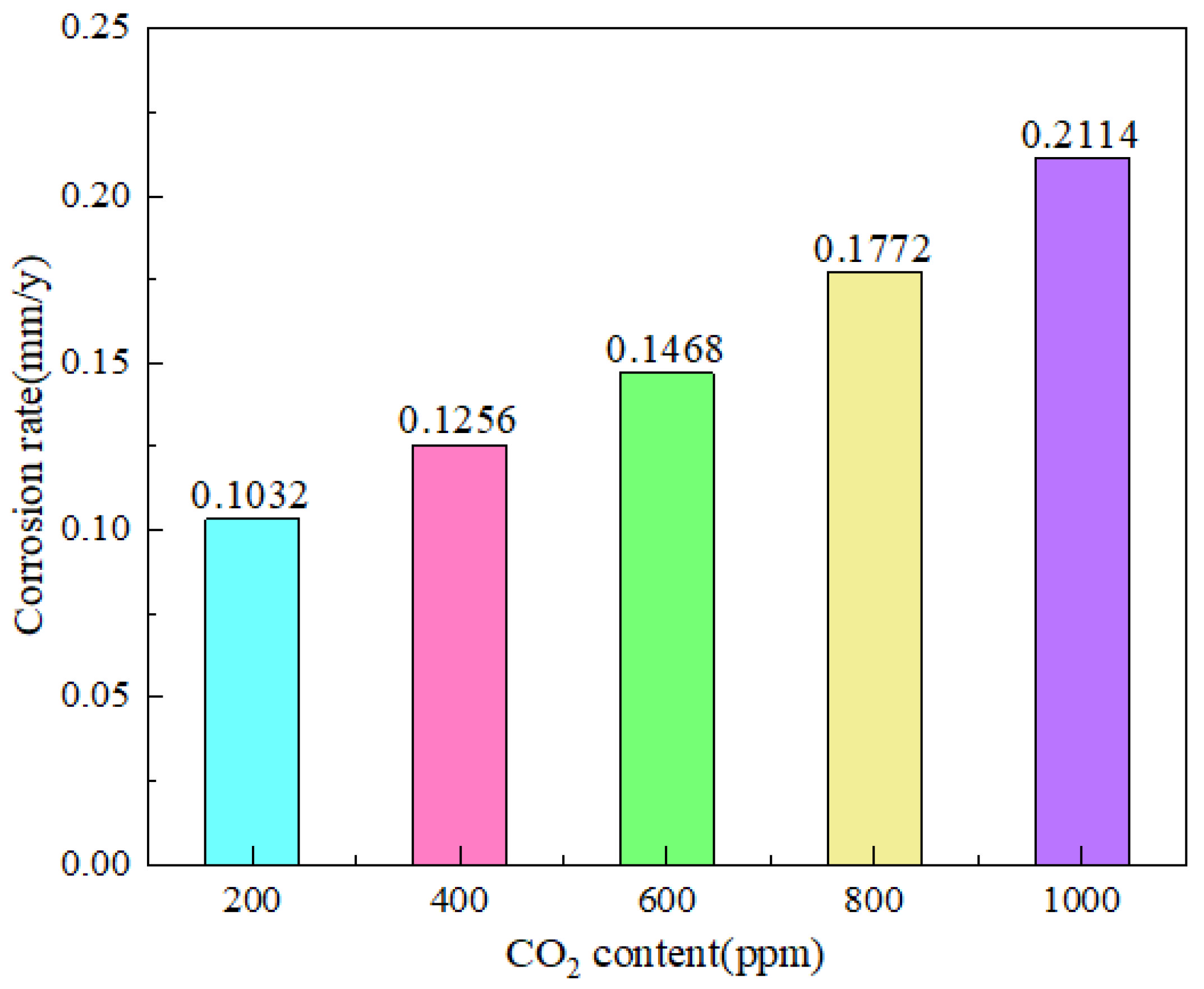

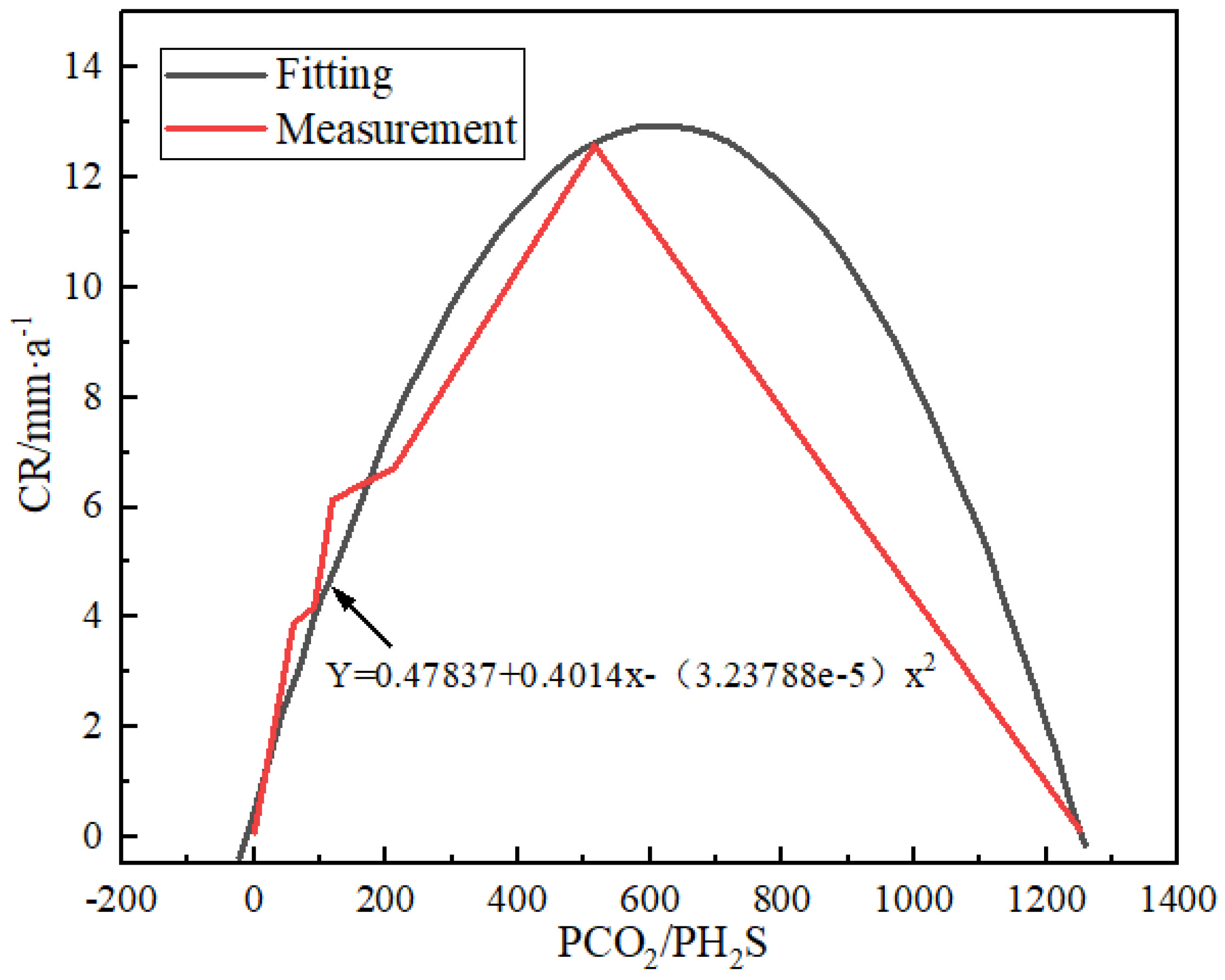

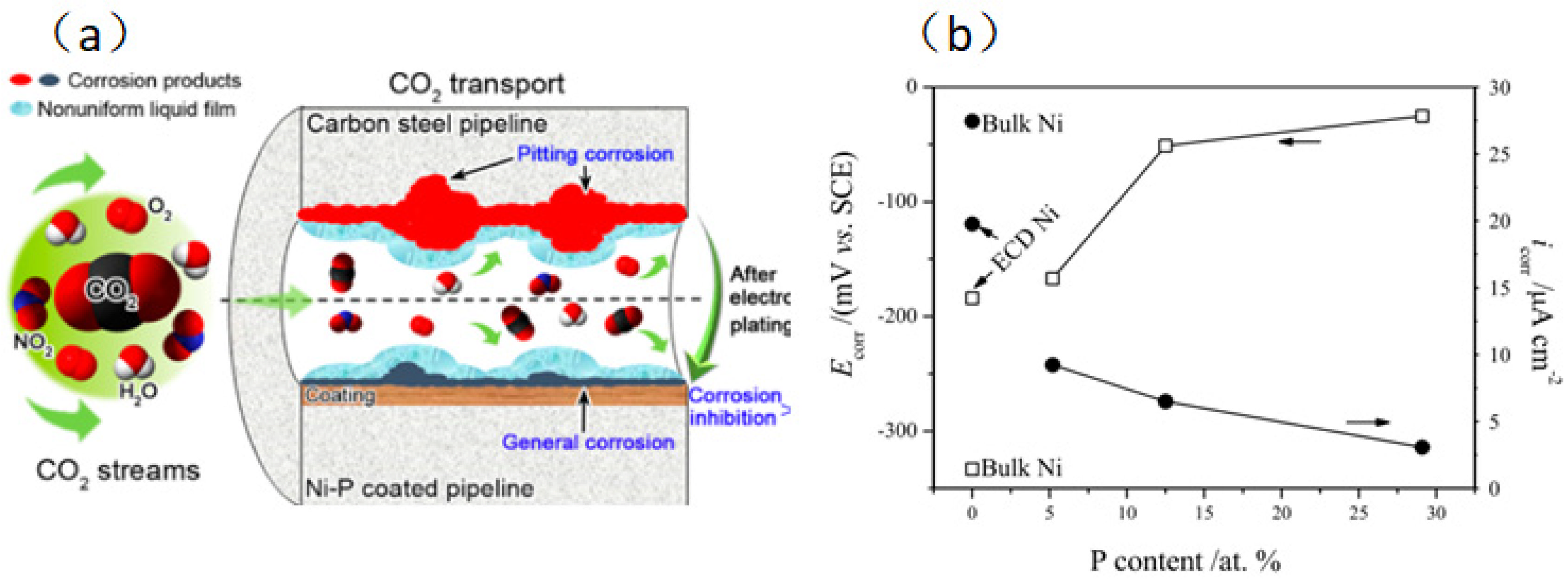
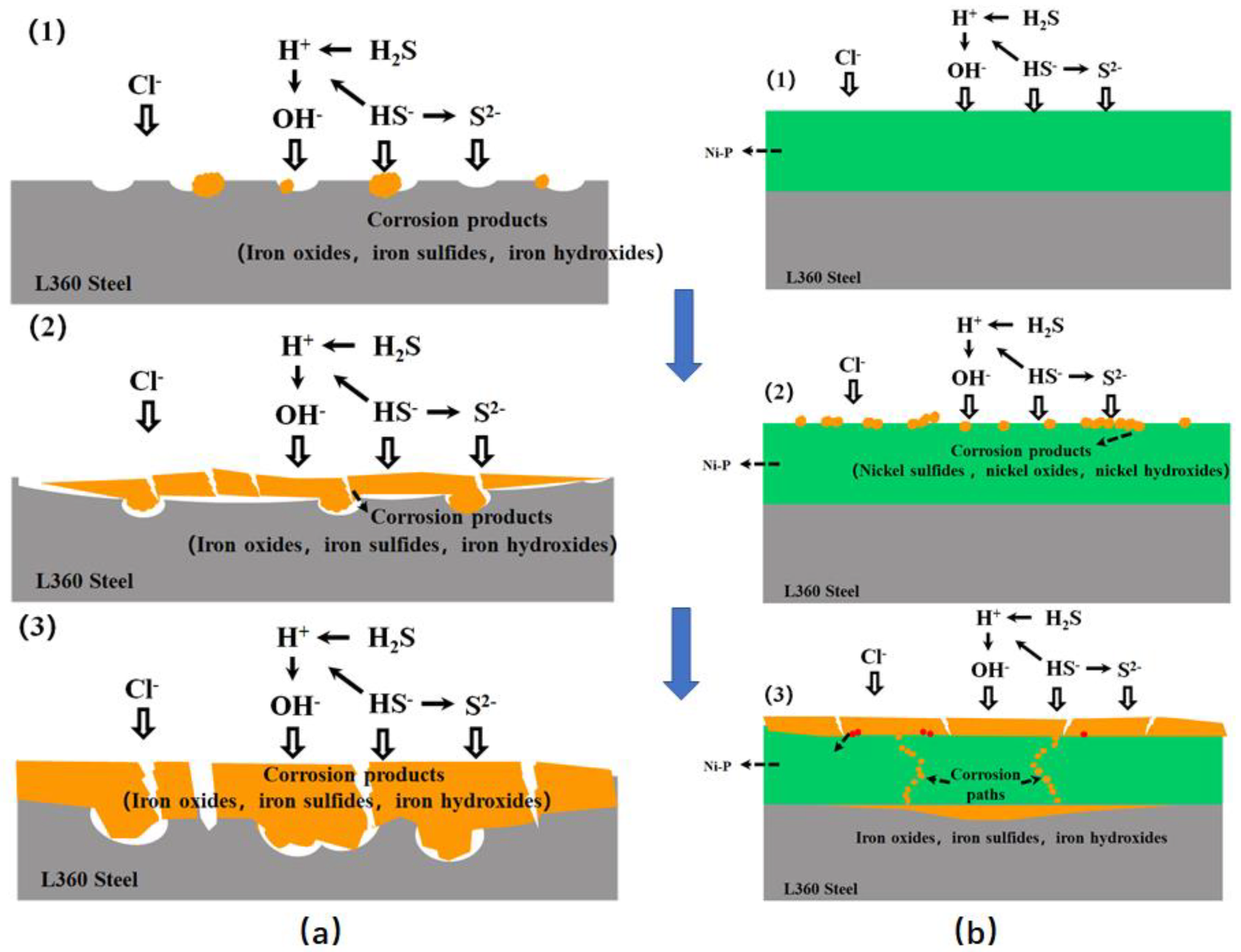

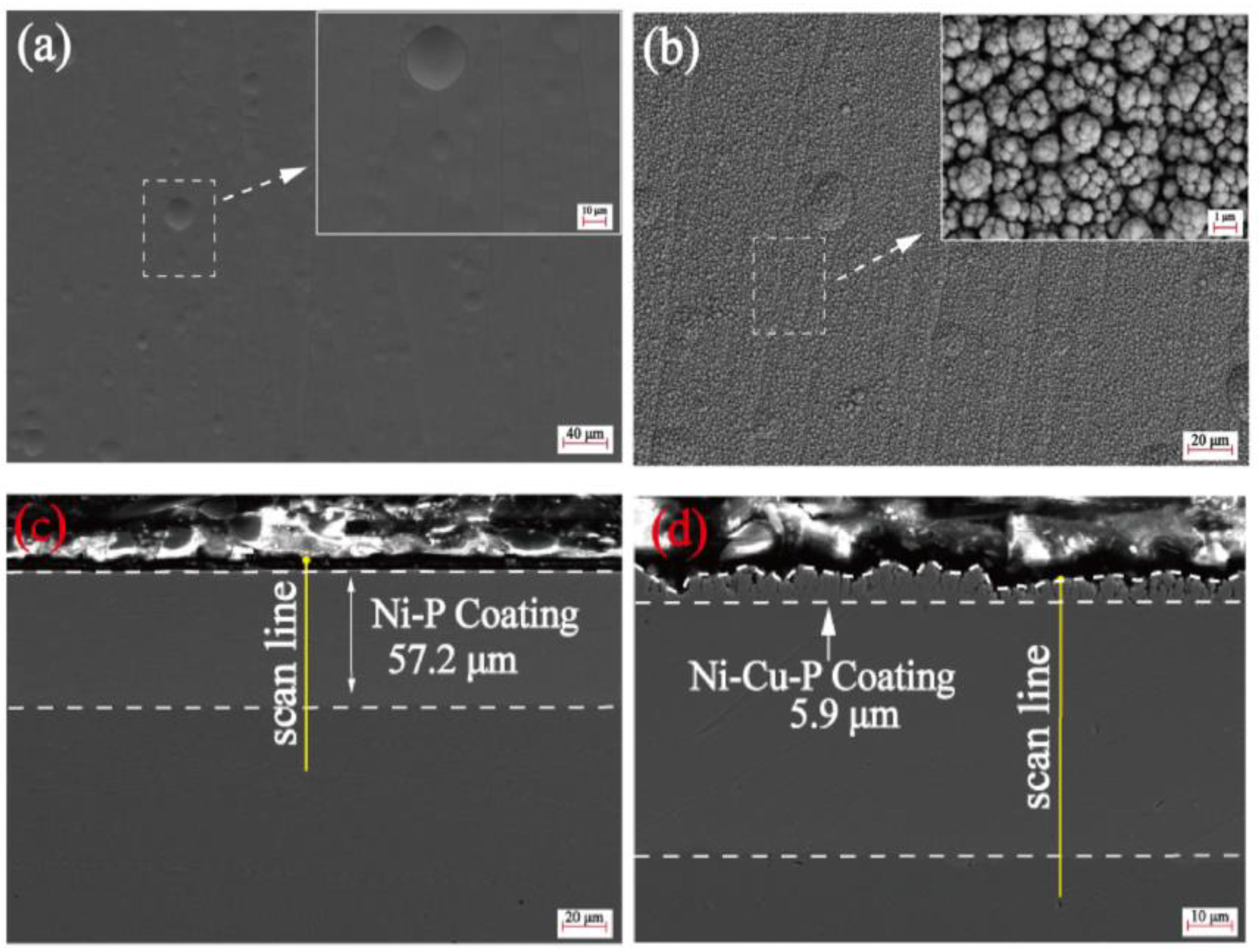

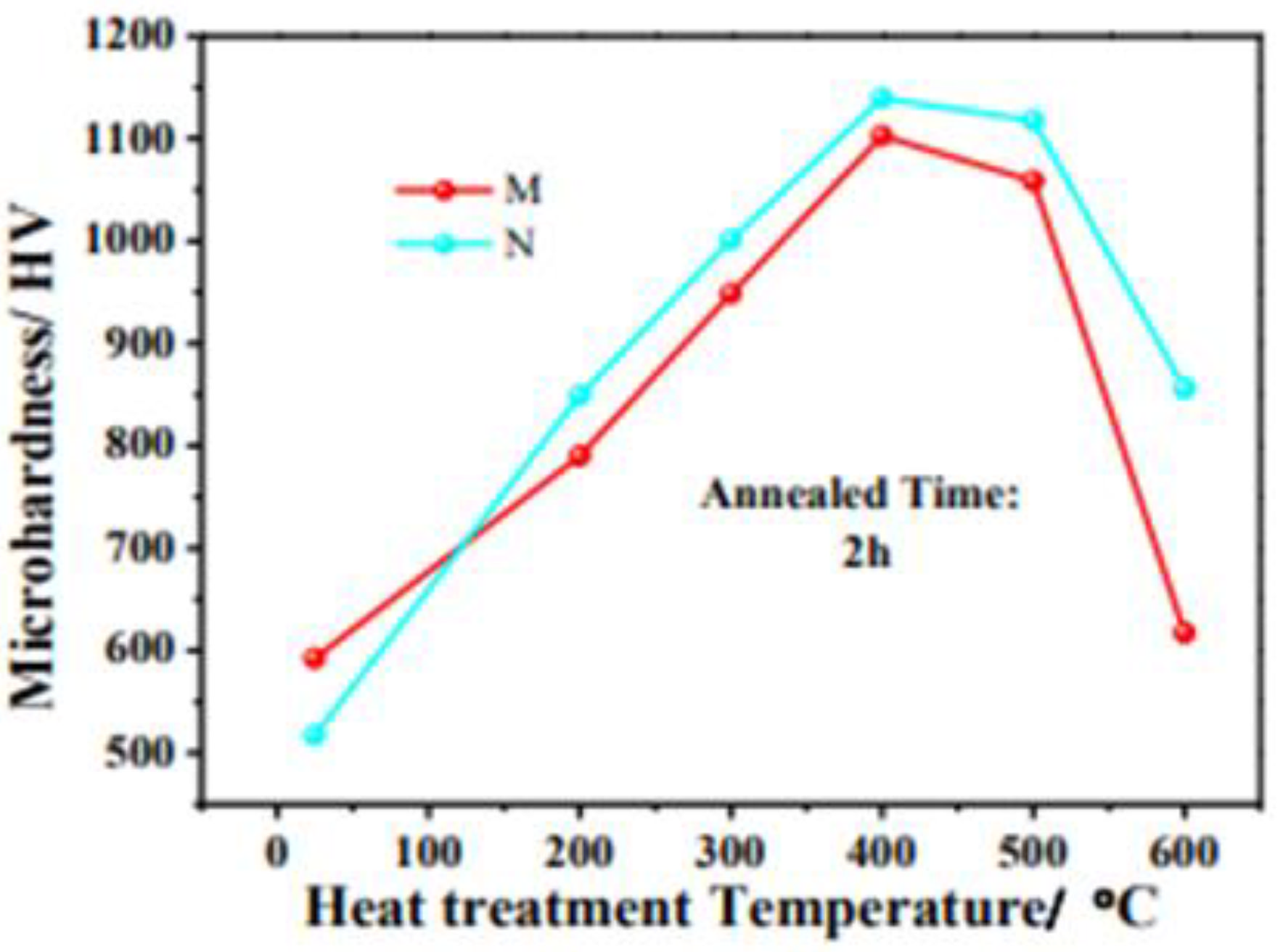

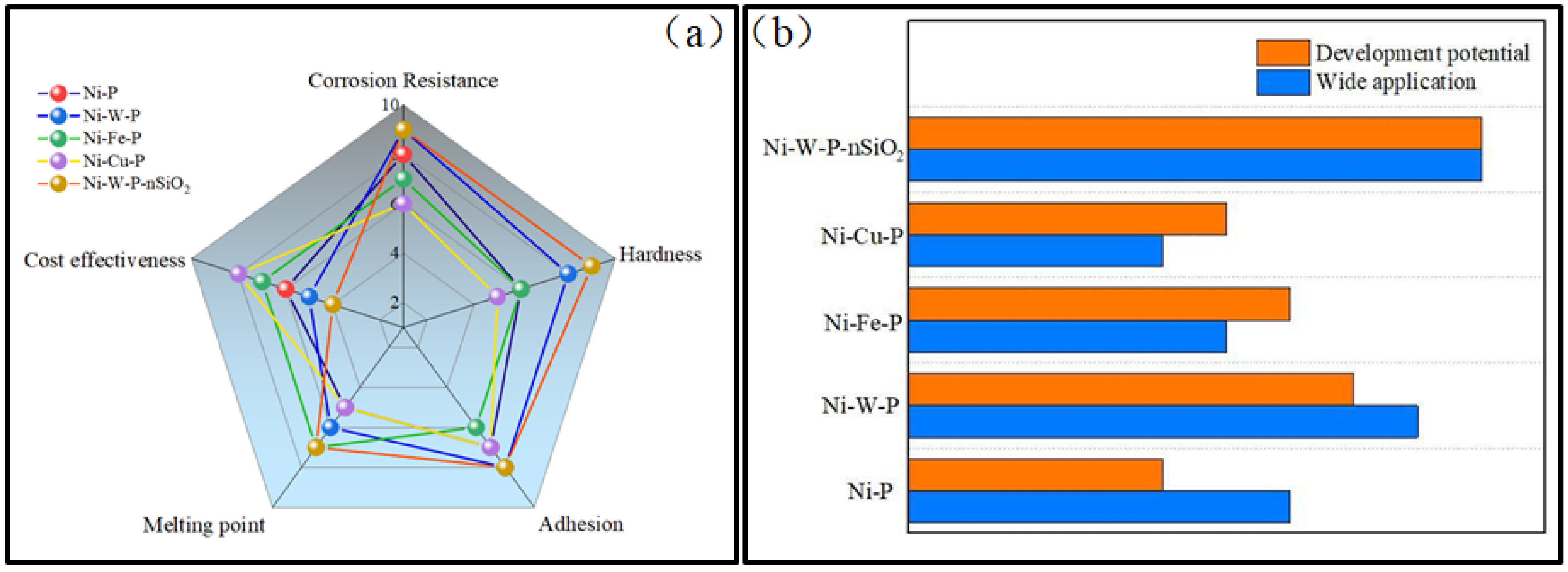
| Type | Application | Cost | Research Directions |
|---|---|---|---|
| Ni-P | It is widely used to protect the surface of equipment, such as pipes, pumps, and valves. Especially in seawater or high chloride ion environments, it can effectively prevent the corrosion of steel pipes and drilling tools. | Relatively low and economical. | 1. Improve high-temperature resistance: Enhance the stability of Ni-P coating at high temperatures through new heat treatment or adding micro-alloy elements; 2. Improve preparation method: Develop an efficient and environmentally friendly electroplating process to reduce energy consumption and environmental impact. |
| Ni-Fe-P | Suitable for working environments that require higher wear resistance, such as wear parts of drilling tools. | Typically slightly more expensive than Ni-P, but the performance advantages in certain high-wear environments can offset the cost. | 1. Optimize alloy composition: adjust the element ratio to improve the wear resistance and hardness of the coating while maintaining ductility; 2. Hydrogen embrittlement resistance: improve the performance of the coating in a high-pressure hydrogen environment to adapt to the extreme conditions of deep well drilling. |
| Ni-Cu-P | Suitable for certain applications where conductivity performance is required. | Slightly higher than Ni-P, but still more economical than other more conductive materials (such as silver coating) | Optimize electrochemical performance: Improve the performance of coatings in applications where electrical conductivity is required. |
| Ni-W-P | Often used in working environments that require extremely high wear resistance and hardness, such as deep-sea drilling equipment. | Higher because of the higher cost of tungsten, but its performance is significant in demanding applications. | 1. Improve wear resistance: Use nanoparticle reinforcement, composite coating, and other methods to further improve the wear resistance of the coating. 2. Surface modification technology: Research laser cladding, electrospark deposition, and other technologies to improve the bonding strength between the coating and the substrate. |
| Ni-W-P-nSiO2 | Suitable for drilling tools, pipelines, and other equipment that require high wear resistance; suitable for harsh conditions such as seawater and high-chloride-ion environments; for equipment working in high-temperature environments. | Relatively high | 1. Optimize nanoparticle dispersion: Study methods to evenly disperse nano-silica particles to improve the consistency and overall performance of the coating. 2. Multifunctional composite coating: Introduce other functional nanomaterials such as MoS2 and graphene to develop multifunctional composite coatings. |
Disclaimer/Publisher’s Note: The statements, opinions and data contained in all publications are solely those of the individual author(s) and contributor(s) and not of MDPI and/or the editor(s). MDPI and/or the editor(s) disclaim responsibility for any injury to people or property resulting from any ideas, methods, instructions or products referred to in the content. |
© 2024 by the authors. Licensee MDPI, Basel, Switzerland. This article is an open access article distributed under the terms and conditions of the Creative Commons Attribution (CC BY) license (https://creativecommons.org/licenses/by/4.0/).
Share and Cite
Zhao, Y.; Zhang, X.; Li, J.; Cao, P.; Wang, G.; Zhang, L.; Jia, S.; Zhao, X.; Peng, H.; Tian, R. Progress in Research on Ni-Based Protective Coatings for Downhole Tubing Steel in CO2 Flooding. Coatings 2024, 14, 871. https://doi.org/10.3390/coatings14070871
Zhao Y, Zhang X, Li J, Cao P, Wang G, Zhang L, Jia S, Zhao X, Peng H, Tian R. Progress in Research on Ni-Based Protective Coatings for Downhole Tubing Steel in CO2 Flooding. Coatings. 2024; 14(7):871. https://doi.org/10.3390/coatings14070871
Chicago/Turabian StyleZhao, Yonggang, Xudong Zhang, Jishun Li, Pengcheng Cao, Guangqin Wang, Le Zhang, Shuqin Jia, Xuhang Zhao, Haoping Peng, and Ruichao Tian. 2024. "Progress in Research on Ni-Based Protective Coatings for Downhole Tubing Steel in CO2 Flooding" Coatings 14, no. 7: 871. https://doi.org/10.3390/coatings14070871
APA StyleZhao, Y., Zhang, X., Li, J., Cao, P., Wang, G., Zhang, L., Jia, S., Zhao, X., Peng, H., & Tian, R. (2024). Progress in Research on Ni-Based Protective Coatings for Downhole Tubing Steel in CO2 Flooding. Coatings, 14(7), 871. https://doi.org/10.3390/coatings14070871




